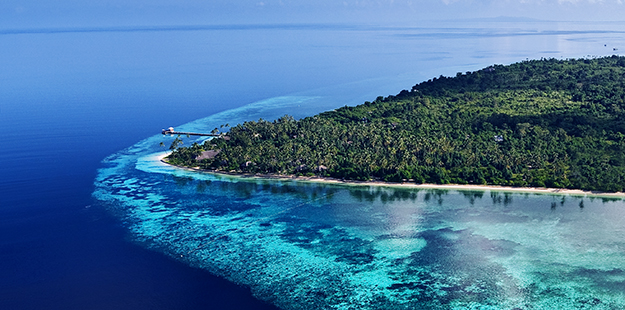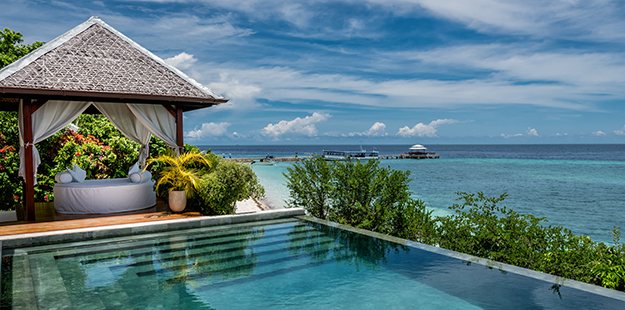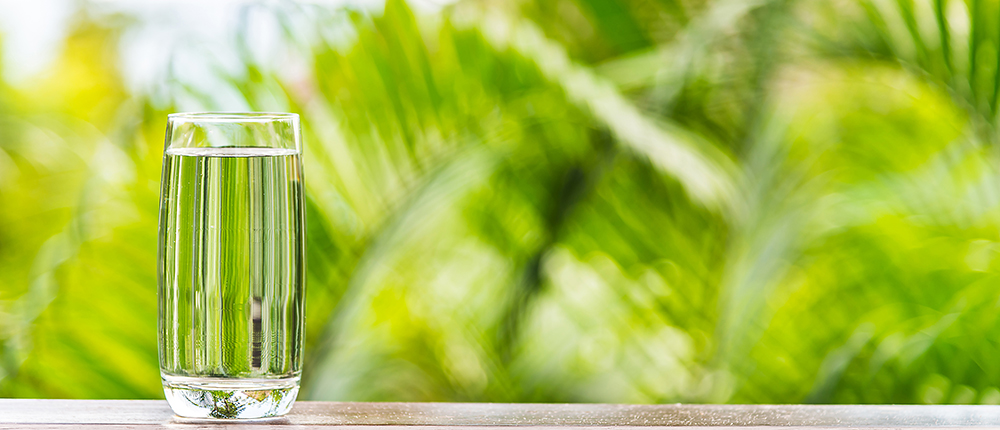Wakatobi’s Water Works
How the resort uses science to ensure an ample, responsible supply of fresh water
After a full day of diving or snorkeling, a refreshing shower is just the thing. Most of us take for granted the drinkable steady streams that flow from showerheads and sinks. But when you think about it, just how does a resort such as Wakatobi generate a seemingly endless supply of fresh, clean water on a small island that receives only modest seasonal rainfall, and has no rivers or other water sources? The answer is actually quite simple, but it does involve a bit of both natural science and basic chemistry.

The small island, called Onemobaa, on which the resort sits, doesn’t have much of a freshwater reservoir, one of the reasons why local people never settled on this site. Photo by Didi Lotze
Limestone sponges
Wakatobi Resort enjoys an idyllic oceanfront setting, where swaying palms front a sandy beach. So why was this prime piece of real estate vacant when one of our founders, Lorenz Mäder, first discovered the site? One of the answers is water. Or the lack thereof. Like thousands of tropical islands around the world, the Wakatobi islands sit on a limestone foundation, which is made up of the remains of seashells and coral, all compacted into rock over millions of years. This porous limestone soaks up any rainwater that falls on the island, creating underground pockets of fresh water. On larger islands in the Wakatobi group, residents have long known how to dig wells and tap into this natural reservoir of groundwater.

Before we transformed into an upscale resort, fresh water was a valuable and somewhat scarce resource. Today, clean, drinkable streams flow from Wakatobi’s sinks and showerheads. Photo by Walt Stearns
Thing is, the small island on which Wakatobi Resort sits doesn’t have much of a freshwater reservoir, and the limited supply of brackish water that does exist isn’t located near the resort. One reason why local people never settled the site. In the early days, when Wakatobi was more outpost than an upscale beach resort, fresh water was a valuable and somewhat scarce resource that was obtained by having the staff paddle back and forth by dugout boat to the adjacent island of Tomia, where they would fill up 20-liter canisters from a public water supply. And if that source was not available, the crew would have to resort to a trick practiced by some of the region’s indigenous sea gypsies, who would collect groundwater seeping from cracks in the rocks during low tide. And after all this painstaking collection and transport, the water would then need to be run through a hand-powered filter to create safe drinking water.
Making water
Like most things at Wakatobi, the water supply has benefited from ongoing upgrades and expansions. The key element to the resort’s ability to provide pure water is a technology known as reverse osmosis. Without getting into the detailed science behind this process, it essentially involves running saltwater through very fine filter elements under high pressure. This literally squeezes the salt molecules out of water, turning brackish groundwater or even ocean water into pure freshwater.

The resort’s bank of four reverse osmosis systems can generate a combined output of 36,000 liters of fresh water per day—plenty for drinking, showers, gear rinses, laundry, kitchen use and even topping off the Villa swimming pools. Photo by Didi Lotze
Today, Wakatobi’s water supply comes from the island’s underground lens of brackish water, which can be more or less salty, depending on recent rains. This brackish water is actually suitable for use in toilets and some cleaning purposes as-is. To create fresh water, the resort employs a bank of four reverse osmosis systems that can generate a combined output of 36,000 liters of fresh water per day — plenty for drinking, showers, gear rinses, laundry, kitchen use and even topping off the Villa swimming pools. Drinking water served at the restaurant, staff canteen and longhouse receive an additional 3-stage treatment that includes UV lamp sterilization, filtration, and microfiltration. When there are some 60 guests in residence, 250 staff on site—of which about 60 of them stay overnight—water consumption will average about 25,000 liters a day. The salty, but fully filtered discharge created by the reverse osmosis process is also useful, as it can be used to balance the chlorinator technology used in our pools.

Next time you enjoy a glass of infused fruit water at Wakatobi’s Longhouse, or sip a fruity drink prepared by our restaurant team, you’ll know the clean water in it is made with lots of loving care. Photo by Didi Lotze
Generating our own water not only allows Wakatobi to ensure guests have all the pure, safe drinking and washing water they desire, it also mitigates our impact on local communities, who need not share their own limited water supplies with the resort. It’s just one more of the ways we look for positive, cooperative solutions to environmental challenges.
Want to learn more about Wakatobi, or better yet plan your next trip? Contact us at office@wakatobi.com, or complete a quick trip inquiry at wakatobi.com. A guest experience representative will be in touch with you to answer your questions and provide information about your next dive/snorkel dream vacation.
Visit us on Facebook.


